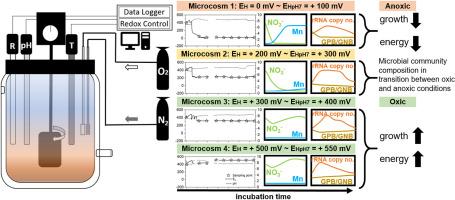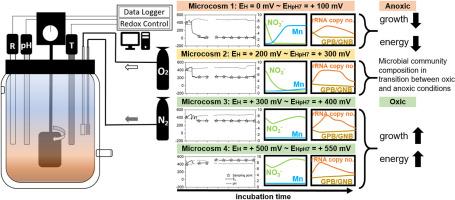控制氧化还原电位和淹水时间对耕地土壤微生物群落组成和生物量的影响
IF 10.3
1区 农林科学
Q1 SOIL SCIENCE
引用次数: 0
摘要
氧化还原条件调节土壤生物地球化学循环和微生物群落。然而,氧化还原电位(EH)对微生物群落组成的影响程度尚不清楚。本研究阐明了受控EH对微生物生物量以及细菌、真菌和古细菌丰度的影响。在100、300、400和550 mV(标准pH值为7)的稳定EH条件下,对具有停滞特性的可耕地土壤进行淹水培养。采用针对16S和18S rRNA基因的磷脂脂肪酸(PLFA)分析和定量聚合酶链反应(qPCR)研究微生物群落组成。此外,在溶解相中测量了相关的电子受体(NO3-, Mn, Fe, SO42-),有机碳(C),氮和营养物质(P和S),以将厌氧呼吸和营养物质有效性与微生物群落组成联系起来。EH和洪水持续时间对微生物生物量和群落组成有影响。细菌、真菌和古细菌基因拷贝数在100 mV时最低,并随淹水时间的延长而降低。在还原和氧化氧化条件下,微生物群落组成存在差异,特别是在100和400 mV之间。与NO3-还原或有氧呼吸相比,这种变化与≥400 mV时的硝化作用和100 mV时的低能量净产率有关。电子受体和养分有效性解释了微生物群落组成变化的50%以上。我们得出结论,EH和洪水持续时间主要通过对电子受体和养分有效性的影响来调节被淹土壤的微生物生物量、群落组成和呼吸途径。本文章由计算机程序翻译,如有差异,请以英文原文为准。


Controlled redox potentials and flooding duration affect microbial community composition and biomass in an arable soil
Redox conditions regulate biogeochemical cycling and microbial communities in soils. However, the extent to which redox potentials (EH) affect microbial community composition remains unclear. This study elucidates the effects of controlled EH on microbial biomass and on bacterial, fungal, and archaeal abundance.
An arable soil with stagnant properties was flooded and incubated under stable EH at 100, 300, 400, and 550 mV (standardized to pH 7). Microbial community composition was investigated by phospholipid fatty acid (PLFA) analysis and quantitative polymerase chain reaction (qPCR) targeting 16S and 18S rRNA genes. Additionally, relevant electron acceptors (NO3−, Mn, Fe, SO42−), organic carbon (C), nitrogen, and nutrients (P and S) were measured in the dissolved phase to link anaerobic respiration and nutrient availability with microbial community composition.
Microbial biomass and community composition were affected by EH and flooding duration. Bacterial, fungal, and archaeal gene copy numbers were lowest at 100 mV and decreased with flooding duration. The microbial community composition differed between reducing and oxidizing redox conditions, especially between 100 and 400 mV. This change was associated with nitrification at ≥ 400 mV and lower energy net yields at 100 mV due to microbial Mn reduction compared to NO3− reduction or aerobic respiration. Electron acceptor and nutrient availability explained over 50 % of variation in microbial community composition.
We conclude that EH and flood duration regulate microbial biomass, community composition, and respiration pathways in flooded soils primarily through their effects on electron acceptor and nutrient availability.
求助全文
通过发布文献求助,成功后即可免费获取论文全文。
去求助
来源期刊

Soil Biology & Biochemistry
农林科学-土壤科学
CiteScore
16.90
自引率
9.30%
发文量
312
审稿时长
49 days
期刊介绍:
Soil Biology & Biochemistry publishes original research articles of international significance focusing on biological processes in soil and their applications to soil and environmental quality. Major topics include the ecology and biochemical processes of soil organisms, their effects on the environment, and interactions with plants. The journal also welcomes state-of-the-art reviews and discussions on contemporary research in soil biology and biochemistry.
 求助内容:
求助内容: 应助结果提醒方式:
应助结果提醒方式:


